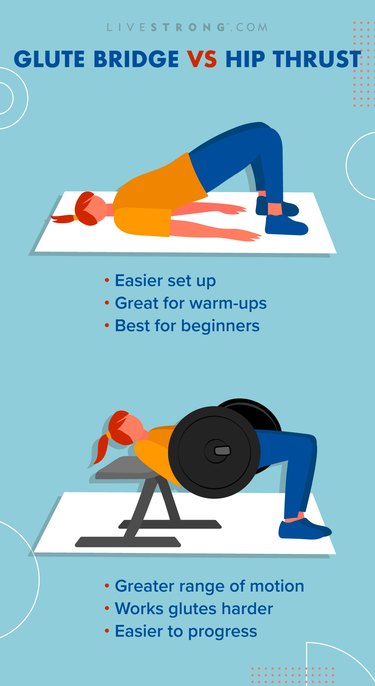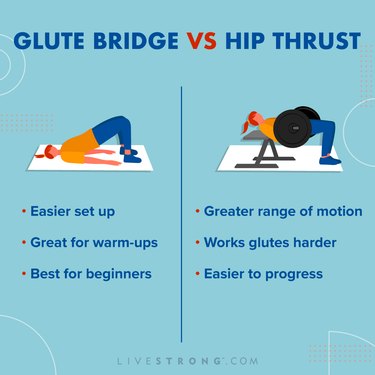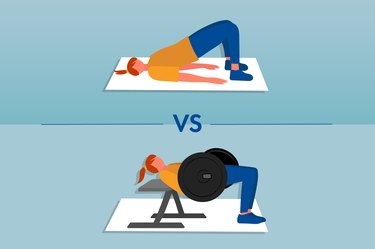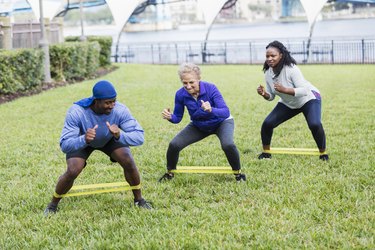


If you have goals of building stronger, bigger glutes, the glute bridge and hip thrust are your friends. Unlike deadlifts and squats, which enlist multiple muscles throughout your lower body, bridges and hip thrusts are all about the glutes.
And while these glute exercises look — and honestly, are — very similar, which one you do matters. So in the hip thrust vs. glute bridge debate, who wins? Well, it depends on your strength levels, goals and, naturally, what equipment you have handy.
Video of the Day
Here's everything you need to know about the differences between the glute bridge and hip thrust — including when to use which for the most well-rounded of glutes.
Glute Bridge 101
A glute bridge is a body-weight exercise that primarily targets the glutes, and is popular in both strength-training and yoga circles.
You do it lying down on your back with your knees bent and feet flat on the floor. Then you lift your hips toward the ceiling until your torso forms a diagonal line from your knees to your neck.
To make the move more challenging, you can do a dumbbell glute bridge or loop a mini band above your knees. The band also works your glute medius — on the upper sides of your hips — says Lisa Schroeder, CPT, a certified personal trainer at Life Time Chanhassen in Minnesota.
Glute Bridge
- Lie on your back with your arms at your sides, feet flat on the ground and knees bent.
- On an exhale, squeeze your glutes, press into your heels and drive your hips up toward the ceiling.
- Raise your hips until your body forms a diagonal line from your knees to your hips to your chest.
- Pause here for a moment.
- Reverse the motion to bring your hips back down to the ground.
Pros
Accessibility: Compared with loaded glute exercises (namely the hip thrust), the body-weight bridge has a relatively low barrier to entry. It's accessible for many newbies and is an ideal way to learn form before progressing to barbell hip extensions, Schroeder says.
No equipment needed: "You can do the exercise anywhere because you don't need any equipment," she says. Try it on your yoga mat or even atop your bed.
Cons
Difficult to progress: You can make glute bridges more challenging with a resistance band or a pair of dumbbells, but anything bigger or heavier can get unwieldy.
So as you get stronger, you'll likely want to progress to a barbell. Note: While you technically can do barbell glute bridges, it's hard to keep the barbell from rolling down your thighs to your face. Watch out!
Small range of motion: When you're lying flat on the ground, your hips can only raise and lower so far. That means you only work your hips through only a portion of their available range of motion. This cuts down on the functionality and overall muscle benefits of the move.
Hip Thrust 101
A hip thrust is popular in weight rooms and is like a glute bridge, except it involves both a bench and (traditionally) a barbell.
With a hip thrust, you begin sitting on the floor with your mid to upper back against the edge of a workout bench or box, knees bent and feet flat on the floor. While seated, you situate a barbell, loaded with rubber weight plates, across the crease in your hips. Then, as you raise your hips, you also raise the bar.
As you get stronger, you can make the move more challenging by simply increasing the weight of the plates on the barbell, or trying these hip thrust variations.
Hip Thrust
- Sit on the floor next to a loaded barbell with your mid back against the edge of a bench or box.
- Place your feet on the floor about hip-width apart. Your feet can be slightly turned out, depending on what feels comfortable for you.
- Place some sort of pad (towel, squat sponge, Hampton thick bar pad, Airex pad) on top of your pelvis. You can also place a barbell sleeve around the bar, so you don't have to worry about anything shifting.
- Roll the barbell onto the crease of your hips.
- Squeeze your glutes and push through your heels to raise your hips and the weight up toward the ceiling. Keep your back flat and head pointed toward the wall in front of you.
- Lock your hips out at the top of the movement by fully extending the hips and squeezing your glutes. Your shins should be vertical, knees neutral or slightly externally rotated and legs forming 90-degree angles.
- Pause, then slowly lower your hips down to return to the starting position.
Pros
Easy to progress: To build your glutes, you need to keep challenging them. And hip thrusts are easy to keep challenging. Just add more weight — there's virtually no limit to how heavy you can load the bar.
Large range of motion: Moving your hips from full flexion to full extension is a major hip thrust benefit. This allows you to work your glutes harder and through a more functional range of motion than is possible when setting up with your back on the floor.
Cons
Not beginner-friendly: The traditional barbell glute bridge requires some base glute strength to perform properly and, because it involves wielding a barbell, it can be intimidating to take on for the first time.
That said, you can do body-weight hip thrusts. You don't often see them in the gym, but that doesn't mean they aren't great.
Equipment needed: Even if you try hip thrusts using just your body weight, or sub in a dumbbell for a kettlebell, you still need something to balance your back on. Exercise benches make the best option because they are about knee-height and have a padded edge.
The Difference Between a Glute Bridge and Hip Thrust

The main difference between the hip thrust and glute bridge is the set-up.
"A hip thrust basically is a glute bridge with more range of motion," says Jason Pak, CPT, a certified personal trainer, USA Weightlifting–certified sports performance coach and co-owner of Achieve Fitness.
Because your back is elevated, there's just a much larger space between the floor and where your hips lock out at the end range. The larger range gives the hip thrust a greater advantage for glute gains for two reasons: It makes it easier to add and lift weight and it better activates the glutes and hamstrings.
The angle at which your body moves in a hip thrust also allows your glutes to be under consistent and constant tension, ultimately encouraging more muscle growth.
"The glutes exhibit the highest levels of muscle activity in a shortened position at the end range hip extension, which is the exact pattern that the hip thrust trains," Pak says. The end range hip extension is the very top of the movement, where your hips are thrust forward and up, and your glutes are squeezing and locked out.
Tip
You can also try a Kas glute bridge, a type of modified hip thrust. Instead of lowering your butt to hover above the ground, you lower only about halfway.
How to Choose: Glute Bridge vs. Hip Thrust
"For all intents and purposes, we view the two lifts as largely the same movement as they both train the hip extension pattern," Pak notes. But there are certain situations where one may be a better option than the other.
Glute Bridge | Hip Thrust |
|---|---|
Beginner-friendly | Muscle growth |
Body-weight | Hip mobility |
Active recovery/warm-up | Heavy lifting |




